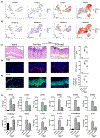TWEAK functions with TNF and IL-17 on keratinocytes and is a potential target for psoriasis therapy
- PMID: 34797693
- PMCID: PMC8756771
- DOI: 10.1126/sciimmunol.abi8823
TWEAK functions with TNF and IL-17 on keratinocytes and is a potential target for psoriasis therapy
Abstract
TNF and IL-17 are two cytokines that drive dysregulated keratinocyte activity, and their targeting is highly efficacious in patients with psoriasis, but whether these molecules act with other inflammatory factors is not clear. Here, we show that mice having a keratinocyte-specific deletion of Fn14 (Tnfrsf12a), the receptor for the TNF superfamily cytokine TWEAK (Tnfsf12), displayed reduced imiquimod-induced skin inflammation, including diminished epidermal hyperplasia and less expression of psoriasis signature genes. This corresponded with Fn14 being expressed in keratinocytes in human psoriasis lesions and TWEAK being found in several subsets of skin cells. Transcriptomic studies in human keratinocytes revealed that TWEAK strongly overlaps with IL-17A and TNF in up-regulating the expression of CXC chemokines, along with cytokines such as IL-23 and inflammation-associated proteins like S100A8/9 and SERPINB1/B9, all previously found to be highly expressed in the lesional skin of patients with psoriasis. TWEAK displayed strong synergism with TNF or IL-17A in up-regulating messenger RNA for many psoriasis-associated genes in human keratinocytes, including IL23A, IL36G, and multiple chemokines, implying that TWEAK acts with TNF and IL-17 to enhance feedback inflammatory activity. Correspondingly, therapeutic treatment of mice with anti-TWEAK was equally as effective as antibodies to IL-17A or TNF in reducing clinical and immunological features of psoriasis-like skin inflammation and combination targeting of TWEAK with either cytokine had no greater inhibitory effect, reinforcing the conclusion that all three cytokines function together. Thus, blocking TWEAK could be comparable to targeting TNF or IL-17 and might be considered as an alternate therapeutic treatment for psoriasis.
Conflict of interest statement
Figures






References
-
- Rachakonda TD, Schupp CW, Armstrong AW, Psoriasis prevalence among adults in the United States. J Am Acad Dermatol 70, 512–516 (2014). - PubMed
-
- Benhadou F, Mintoff D, Del Marmol V, Psoriasis: Keratinocytes or Immune Cells - Which Is the Trigger? Dermatology 235, 91–100 (2019). - PubMed
-
- Li N, Yamasaki K, Saito R, Fukushi-Takahashi S, Shimada-Omori R, Asano M, Aiba S, Alarmin function of cathelicidin antimicrobial peptide LL37 through IL-36γ induction in human epidermal keratinocytes. J Immunol 193, 5140–5148 (2014). - PubMed
Publication types
MeSH terms
Substances
Grants and funding
LinkOut - more resources
Full Text Sources
Medical
Molecular Biology Databases
Miscellaneous

